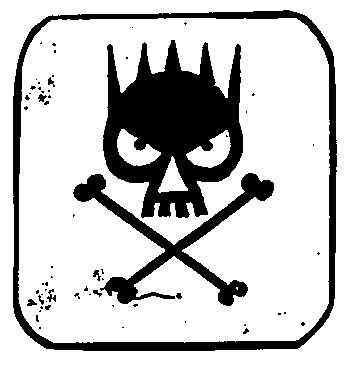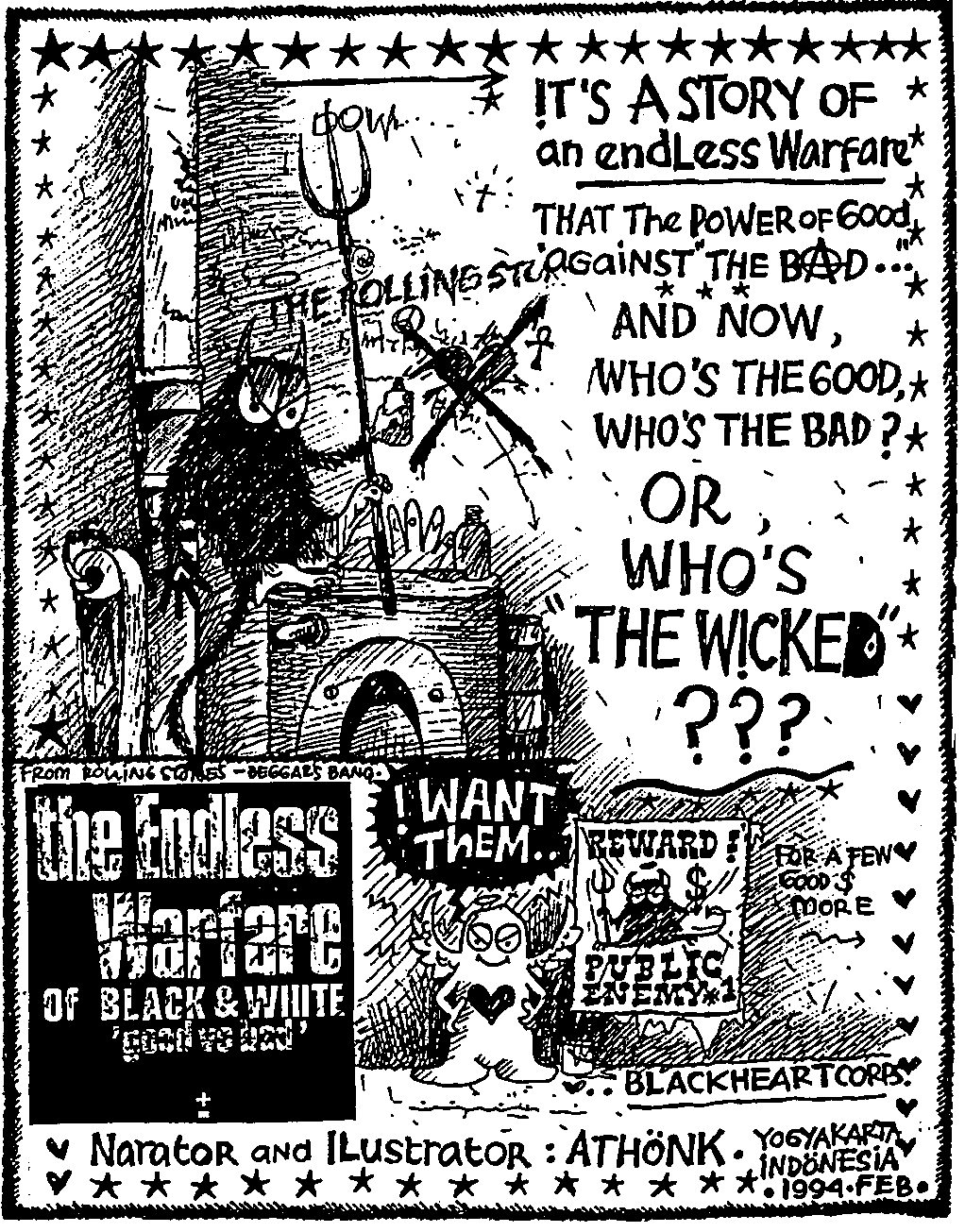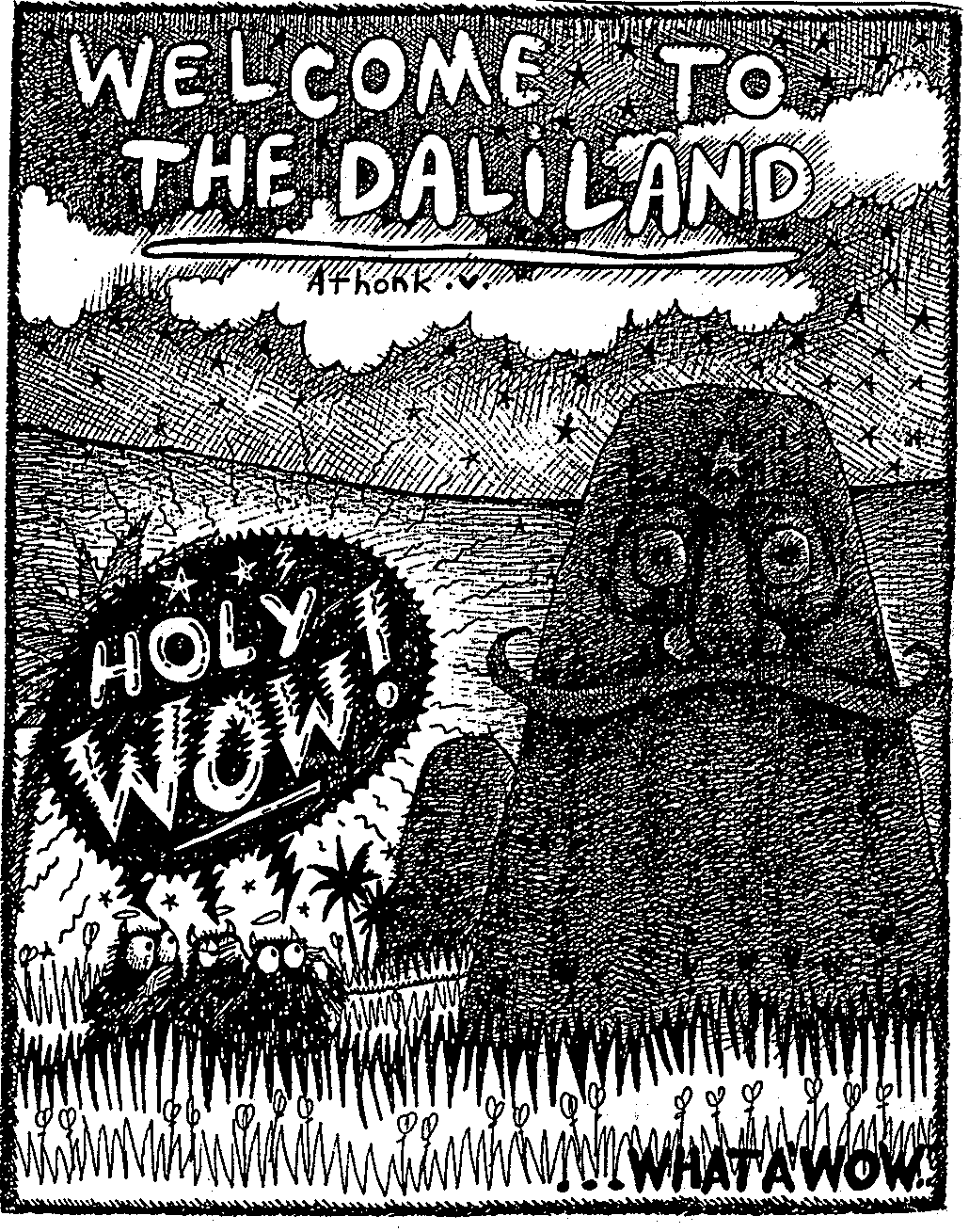Paint it Black in Daliland: Introduction to the
Bad Times Story 
By Laine
Berman
This first published
edition of Athonk’s Bad Times Story is likely a major breakthrough in the
art of comic artistry in Indonesia. Since the golden age of Indonesian
comics, back in the 1960s through 70s (which died with accusations of subversion
and denounced as garbage and poison), the local comic industry has been
overrun by foreign comics.
Beginning with the 1980s,
translations of Donald Duck, Spiderman, Flash Gordon and other American
and European Favorites have filled the book shop shelves, while their Indonesian
native cousins wallow in the dust of neglect, if, that is, they can even
be found in the storage bins. By the end of the 80s, translations
of Japanese and Chinese comics such as Dragon Ball, Candy, and Kung Fu
Boy entered the local scene with their more “eastern” styles of story-telling
and drawing. Indonesian comics, reduced to the efforts of a handful
of artists who tend to present witty and often sarcastic social commentary,
appear only in newspapers, one page of the Sunday comics supplement, and
in weekly magazines.
It was not just the success
in sales of foreign comics that has squeezed the local varieties off the
shelves. Since production expenses and the time it takes to publish local
stories are much greater than buying the rights to established foreign
comics, local producers have little incentive to support local artists.
Furthermore, Indonesian comic artists now copy presentation styles of foreign
comics, neglecting their own history and perspectives on humor or traditions
of story-telling, making their own efforts seem obsolete or inferior. With
no opportunities for publication now, and a fairly dead tradition, comic
artistry seemed to have taken its final bow.

In light of such a
sad history, Athonk’s effort here should indeed be recognized as a rarity.
Born in Semarang into a military family, Athonk claims to have grown up
drawing comics, most of which were borrowed and circulated by friends.
With an obvious talent for drawing, he insists pictures without words are
empty. This comic influence does appear very clearly in his posters, graphics,
and sketches, with their brightly colored, cheerful and rather chaotic
little mosaics of activity splashed over with words, names, places, events.
Closer inspection however, reveals there is an awful lot more going on
within these frames than viewers would initially recognize. Each
contorted frame within the jumbled mass depicts actual and symbolic events
in Indonesian history as well as the artist’s own history as a citizen
of Indonesia. The idealism of youth mixes right in with some rather biting
social and political commentary. Yet my own dilemma in writing this rests
in how to assist readers in knowing where one ends and the other begins.
First inspection of
the Bad Times Story reveals that all the main characters are devils.
Yet, a demonic appearance does not necessarily signify evil just as Athonk’s
own appearance, a fondness for punk gear, chains, and a mohawk haircut,
does not signify a rejection of his Javanese heritage. Nothing is what
it seems and all things must be taken for their own merit. Such a
seemingly simple statement, however, resonates with an objectivity that
is rare and even outlawed in the de-politicized world of modern Indonesia.
But what have devils with halos, punks in conservative Java, and questions
of good and evil have to do with Indonesian politics? As the artist
writes, the Bad Times Story is “a story of an endless warfare”. But
where is this war? It is a war of independence from oppression, the
battle to be an individual, to speak freely and question the rules of order.
It is a battle to survive in whatever way one sees fit. But in the
narrow confines of local society, this translates as a battle for the right
to choose one’s road, one’s own means of expression in a world where such
freedoms are illegal. Thus, as in Athonk’s everyday life, the idealism
of youth, the social pressures to conform, and major questions of which
is good and which is truly evil despite all appearances, ring throughout
this story.
Linguistically also,
the Bad Times Story needs explanation. It is written in an English
that the artist insists must not be ‘corrected’. Having grown up
in the sharply contrasting environments of a military base in Semarang
and Jalan Sosrowijayan in Yogyakarta, Athonk learnt English through frequent
associations with tourist and the other local youths who make their living
serving them in the Sosro area. This comic is, then, written in what
is generally termed “Sosro” English. But there are some fascinating
twists here. Since Athonk is also an avid rock and roll, film, and American
culture fan, he has a uniquely vast vocabulary of rock lyrics, quotes,
cliches, and other formulaic phrases through which he communicates.
Not all of these cliches are presented here in their recognizable forms
and many have been superimposed upon others. For example, the “Angel
in Disguise” is on a mission to “seek and destroy” in order to satisfy
his “appetite of destruction” and the “first falling” is followed by the
“second coming”. “Holy WOW” and the frequent jumbling of rock lyrics
might seem a bit confusing to the non-native English speaker, especially
those who are not rock connoisseurs. Meanwhile, long term Rolling
Stones fans will have a distinct advantage here where no attempts are made
to disguise blatant borrowing.

Regardless of how ‘odd’
the language may seem, English is the language of free speech and expression,
and as such, it is the language of choice even for those who may not be
proficient enough to pass as native users. Clearly, proficiency is
not Athonk’s concern, while careful reading displays a much more biting
social criticism than could ever be expressed in a more conventional language.
Readers should keep in mind that even though they may recognize the source
of the lyric or cliché, nothing is necessarily what it may seem.
In terms of visual
symbols, the three devils we accompany through their adventures frequently
reveal themselves to be just as blind, deaf, and mute as the three monkeys
in many other popular cultures. Such ignorance is not at all coincidental.
The formulaicity of their language mirrors the limitations on freedom of
speech and creative expression so common in this modern world. The stone
heads of Easter Island and Poso, Sulawesi are introduced here with Athonk’s
own twist. They are given the facial features of Salvador Dali and
are located in a tropical island paradise called “Daliland”. Why
Dali? Firstly, Athonk’s father’s name is Dalijo. Second, one
of the major art movements in Indonesia is Surrealism with Dali as the
major influence. Daliland then is symbolic of the Indonesian art
circles that have censored Athonk’s artwork as too political, preventing
him from public exhibition. While first appearances may not seem
terribly striking, look closer at these Daliland figures and you will see
how militaristic their features are. These statues are then huge,
ever-present, overwhelming military figures, staring out over and threatening
everything that occurs on Daliland.
This edition of the
Bad Times Story includes the first two episodes of the first exclusively
Indonesian original comic book to be presented in years. In light
of all our struggles to reach maturity with at least a meager understanding
of good and bad, right and wrong, we should hail Athonk’s efforts here
as a brave and highly personal account of the conflicts associated with
such development from Indonesia. Yet despite the periodic and occasionally
serious limitations placed on his own freedoms, Athonk continues to battle
against the forces of good and evil, never quite knowing which is which.
The idealism of youth prevails in his own attempts at understanding what
freedom of expression may mean. Such an effort deserves both respect
and support.
Selamat membaca!
Laine
Berman
Yogyakarta, 11 November, 1995
Back to Unofficial Athonk Fan Page


